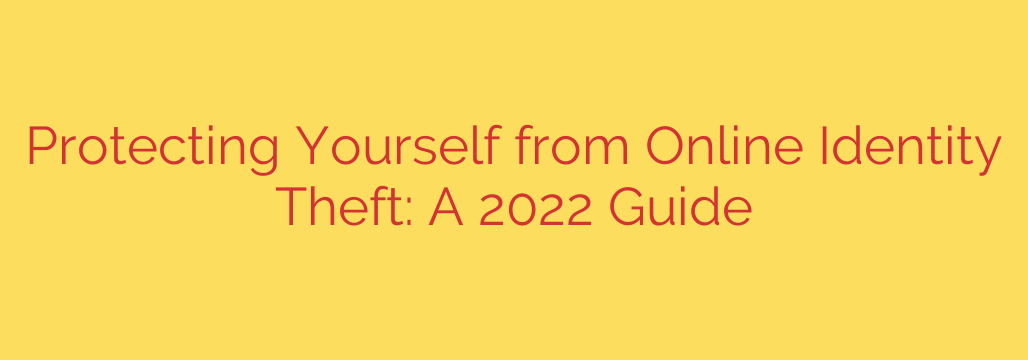
Your Essential Guide to Preventing Online Identity Theft
In our increasingly digital world, our personal information is more valuable—and more vulnerable—than ever before. Identity theft is no longer a rare occurrence; it’s a pervasive threat that can lead to financial loss, damaged credit, and immense personal stress. Protecting your digital identity requires a proactive and vigilant approach. This guide will walk you through the essential steps to secure your personal data and shield yourself from criminals.
Understanding the Threat: What is Online Identity Theft?
Online identity theft occurs when a criminal steals your personal information—such as your name, Social Security number, credit card details, or bank account information—to commit fraud. They might use this data to open new lines of credit, file fraudulent tax returns, drain your bank accounts, or impersonate you for other malicious purposes.
The key to prevention is making it as difficult as possible for thieves to access your information in the first place.
Core Strategies for Proactive Protection
Building a strong defense against identity theft involves several layers of security. Integrating these habits into your digital life is the most effective way to stay safe.
1. Create Fort Knox-Level Passwords
Your passwords are the first line of defense. Weak, reused, or easily guessable passwords are an open invitation to hackers.
- Complexity is Key: A strong password should be long (at least 12-15 characters) and include a mix of uppercase letters, lowercase letters, numbers, and symbols.
- Uniqueness Matters: Never reuse passwords across different websites. If one site is breached, criminals won’t be able to access your other accounts.
- Use a Password Manager: Remembering dozens of complex, unique passwords is nearly impossible. Use a trusted password manager to generate and store highly secure passwords for all your accounts. You only need to remember one master password.
2. Enable Multi-Factor Authentication (MFA)
Multi-factor authentication adds a critical second layer of security. Even if a thief steals your password, they won’t be able to log in without access to your second verification method—usually a code sent to your phone or generated by an authenticator app.
Always enable MFA (sometimes called two-factor authentication or 2FA) wherever it’s offered, especially on sensitive accounts like your email, banking, and social media profiles.
3. Recognize and Avoid Phishing Scams
Phishing remains one of the most common ways criminals steal information. These are deceptive emails, text messages, or phone calls designed to trick you into revealing personal data. Watch for these red flags:
- A sense of extreme urgency or threats.
- Poor grammar and spelling.
- Requests for personal information, login credentials, or financial details.
- Suspicious links or unexpected attachments.
The golden rule is simple: Never click on suspicious links or download unexpected attachments. If an email seems to be from your bank or another service, navigate to their official website directly in your browser instead of clicking the link in the email.
4. Secure Your Devices and Network
Your computer, smartphone, and home Wi-Fi network are all potential entry points for criminals.
- Keep Software Updated: Regularly update your operating systems, browsers, and antivirus software. Updates often contain critical security patches that protect you from the latest threats.
- Secure Your Home Wi-Fi: Ensure your home Wi-Fi network is protected with a strong, unique password and uses WPA2 or WPA3 encryption. Avoid using public Wi-Fi for sensitive activities like online banking.
- Use Security Software: Install reputable antivirus and anti-malware software on your devices and keep it running.
5. Be Mindful of What You Share Online
Cybercriminals often scour social media profiles for personal information that can be used to answer security questions or craft targeted phishing attacks.
Review your privacy settings on all social media platforms and limit the amount of personal information you share publicly. Treat your personal information like cash—don’t leave it lying around for anyone to see. Details like your full birth date, hometown, or pet’s name can be valuable to a thief.
Monitoring for Trouble and Taking Action
Even with the best precautions, it’s vital to monitor your accounts for signs of fraudulent activity.
1. Regularly Monitor Your Accounts
Make it a habit to review your financial statements and credit reports regularly. Check your bank and credit card statements at least once a month for any transactions you don’t recognize. You are entitled to a free credit report from each of the three major credit bureaus (Equifax, Experian, and TransUnion) every year. Stagger your requests to get one report every four months.
2. What to Do If You Suspect Identity Theft
If you discover suspicious activity, act immediately to limit the damage.
- Freeze Your Credit: Immediately place a fraud alert or credit freeze with the major credit bureaus. A freeze is the most effective tool, as it prevents anyone from opening new credit in your name.
- Contact the Involved Companies: Notify the fraud departments of the banks, credit card companies, or other institutions where the fraud occurred. Close any compromised accounts.
- Report the Theft: File an official report with the Federal Trade Commission (FTC) at IdentityTheft.gov. This creates an official record that is essential for disputing fraudulent charges and clearing your name.
- Change Your Passwords: Immediately change the passwords on any compromised accounts, as well as on any other accounts that used the same or similar passwords.
By taking these proactive and responsive measures, you can significantly reduce your risk of becoming a victim of online identity theft and maintain control over your digital life.
Source: https://kifarunix.com/how-to-protect-from-identity-theft-online-a-detailed-guide-for-2022/








